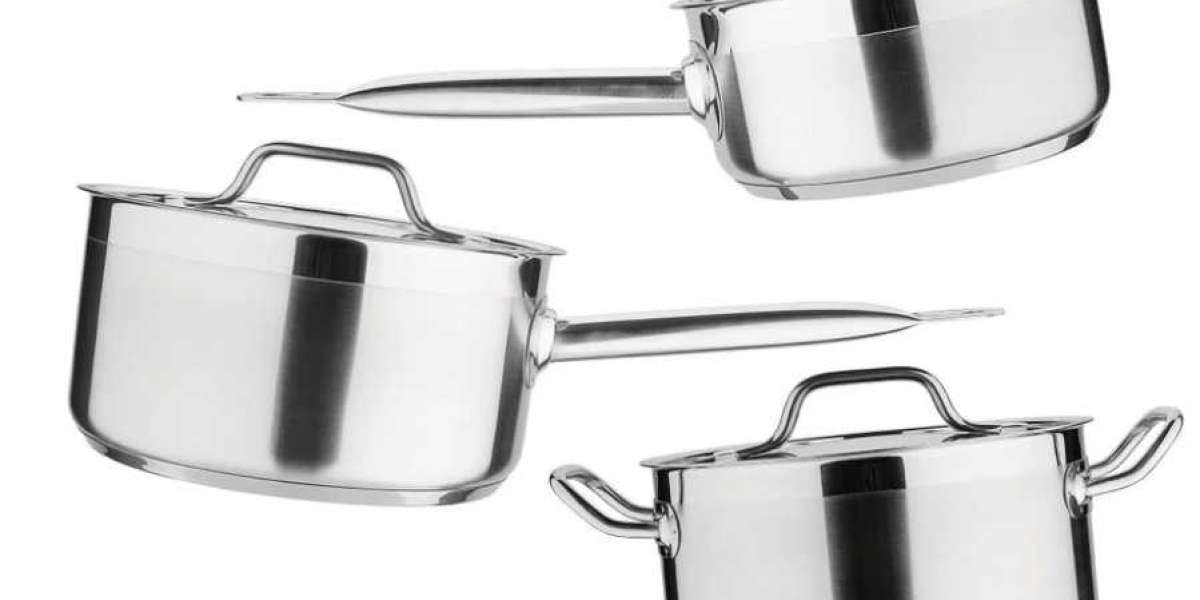What Are Cooking Pots?
Cooking pots are large, deep metal containers designed for boiling, simmering, or cooking food over a stove or in an oven. They come in various sizes and materials, each with its unique features. Some pots have a broad, flat base, while others are taller with narrow openings. The materials used in making these pots can affect how they heat food and how easy they are to clean.
Different Types of Cooking Pots
Not all cooking pots are made equal. Depending on your cooking, you might need a specific type of pot. Here are a few common types of cooking pots to help you decide which one suits your needs:
Stock Pots
Stock pots are large and deep, perfect for preparing large quantities of soup, broth, or stew. They have high sides and a broad base, allowing for even heat distribution. If you like making big batches of soup or stew, a stock pot should be at the top.
Saucepans
Saucepans are more petite than stock pots and are typically used for cooking sauces, heating liquids, or boiling small amounts of food. They come in different sizes, from one to four-quart capacities. A saucepan is essential for everyday cooking, especially when making sauces or heating milk.
Dutch Ovens
Dutch ovens are heavy, thick-walled cooking pots often used for slow cooking, braising, or baking. They are great for cooking stews, roasts, or even baking bread. These pots are usually made from cast iron and can retain heat for a long, making them perfect for long cooking times. If you're a fan of slow-cooked meals, investing in a high-quality Dutch oven will be worth it.
Sauté Pans
Sauté pans have a broad, flat base with slightly higher sides than a frying pan. They're designed for cooking at higher heat and are typically used for searing or sautéing vegetables and meats. If you're looking to cook quickly, especially when using oils or butter, a sauté pan can help you achieve perfect results.
Stock Pots vs. Cooking Pans: What's the Difference?
While stock pots are deep and typically used for larger quantities of liquid, cooking pans or skillets tend to be shorter and have a flat surface. The best cooking pans are used for tasks like frying, browning, and sautéing. If you're unsure whether to use a stock pot or cooking pan, think about the task. Stock pots are best for something with a lot of liquid or a slow simmer, while a cooking pan might be more suitable for tasks like frying or searing.
Materials of Cooking Pots
Cooking pots come in a range of materials, each offering different benefits. Here are the most common materials used in making cooking pots:
Stainless Steel
Stainless steel is one of the most popular materials for cooking pots. It is durable, resistant to rust and stains, and easy to clean. Stainless steel pots typically have an aluminum or copper core for better heat distribution. They are an excellent option for everyday cooking and are known for their long-lasting quality.
Cast Iron
Cast iron is a heavy material that retains heat well, making it ideal for slow cooking. Cast iron cooking pots, especially Dutch ovens, are known for maintaining even heat for long periods. They are perfect for braising, baking, and slow cooking. However, they need to be cared for properly to avoid rusting.
Aluminum
Aluminum pots are lightweight and heat up quickly. While they're less durable than stainless steel or cast iron, they are a great budget option for everyday cooking. An aluminum pot can be a good choice if you need a cooking pot for basic tasks like boiling or making soups.
Nonstick
Nonstick cooking pots are coated with a layer that prevents food from sticking to the surface. The pots are easy to clean and require less oil for cooking, making them great for preparing low-fat meals. However, nonstick coatings can wear down over time, so it's essential to use utensils that won't damage the coating.
How to Choose the Best Cooking Pots
There are a few factors to consider when looking for the best cooking pots. The right choice depends on your cooking style, preferences, and budget. Here's what to keep in mind when making your decision:
Size
Cooking pots come in various sizes, so think about your cooking. If you often cook for large groups, consider a larger pot like a stock pot or Dutch oven. A medium-sized saucepan or sauté pan might be the best fit for smaller meals or everyday use. Always think about the portions you typically prepare and choose the size accordingly.
Material
The material of the pot affects how it conducts heat, how easy it is to clean, and how long it will last. Stainless steel and cast iron are known for their durability and even heat distribution, while aluminum is lightweight and affordable. Nonstick pots are easier to clean but may only last briefly.
Versatility
If you want to invest in a versatile pot, consider one that can be used for multiple cooking tasks. Some pots can be used on the stovetop, in the oven, or even under a broiler. Versatile cooking pots will save you time and space in the kitchen.
Budget
Cooking pots can range in price from affordable options to high-end brands. Consider your budget and look for pots that offer the best value for your money. While higher-end pots may be more expensive, they often last longer and perform better.
Maintenance
Some cooking pots, like cast iron, require special care to keep them in good condition. Others, like stainless steel, are much easier to maintain. Choose a pot that fits your lifestyle and the amount of time you're willing to spend on maintenance.
Conclusion
In conclusion, cooking pots are an essential part of every kitchen, and choosing the right one can make cooking easier and more enjoyable. Whether you need a large stock pot for soups and stews, a versatile Dutch oven for slow cooking, or a nonstick saucepan for sauces, there's a pot out there for you. Take the time to consider the material, size, and versatility of the pots you're choosing, and you'll be well on your way to cooking delicious meals in no time. Happy cooking!














